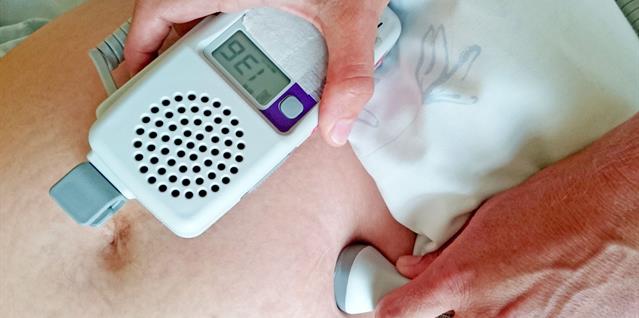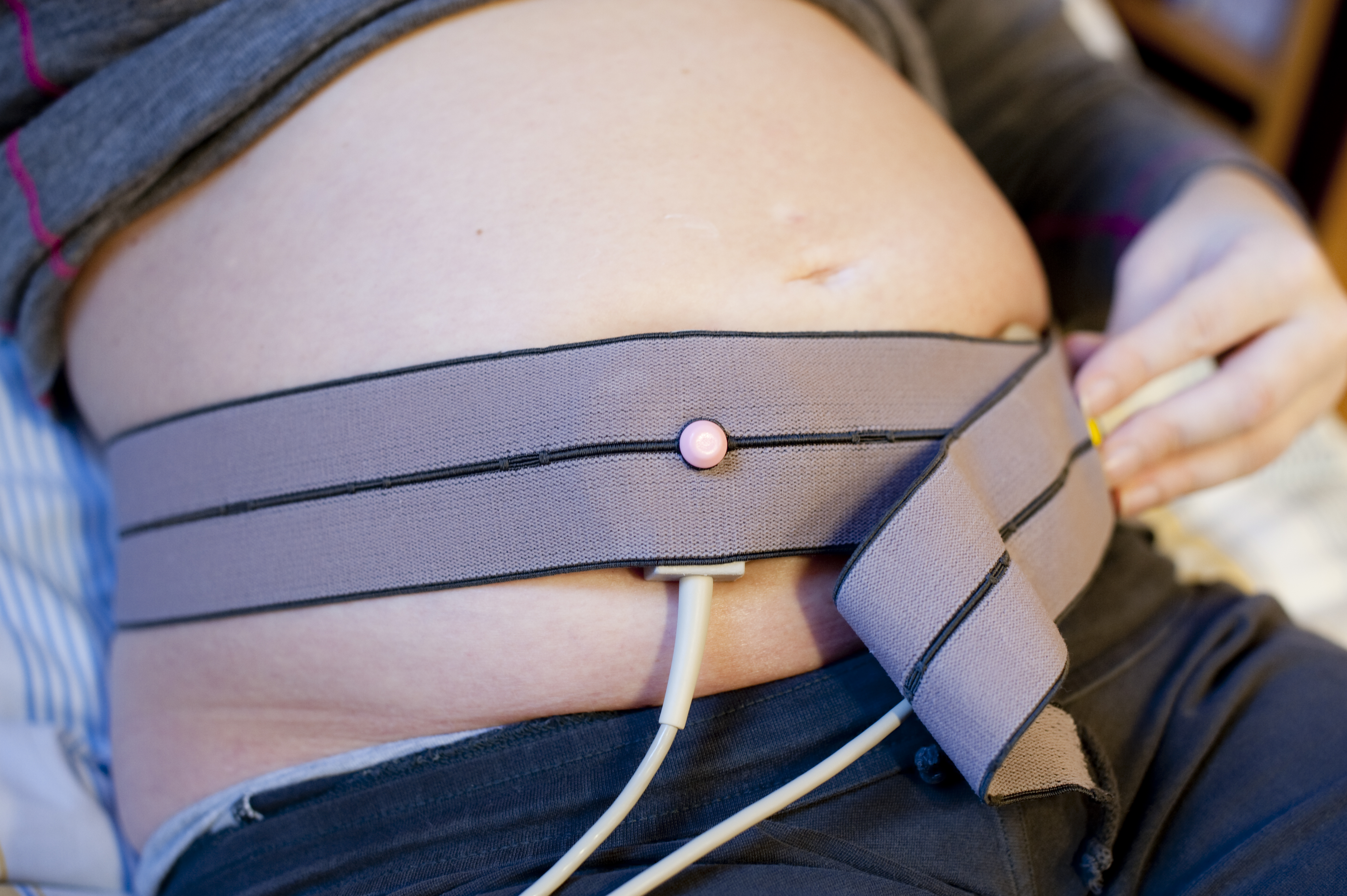What Does a Baby Sound Like on a Fetal Ddopoker
Fetal monitoring
Childbirth is a challenging process for both female parent and kid, and the midwife or dr. will monitor the baby's health throughout the nascency.
The process of childbirth is important for preparing the baby for life outside the womb. The force and pressure exerted on the baby by the contractions and during the baby's passage through the birth culvert are of import for what happens to the baby in the transition from life in the womb to life exterior.
During pregnancy
Fetal movements and kicks
After pregnancy week xviii, nearly meaning women volition start to feel their babe moving and kicking. You lot will gradually get to know your babe's rhythm and periods of activeness.
Some fetuses/babies are more active at certain times of the day, while others respond through kicking, being active and loud noises, or when the mother is active or has but eaten, etc. From pregnancy week 28, you should feel the baby moving/kicking at to the lowest degree ten times a 24-hour interval.
Every bit your stomach grows and there is less room for the baby to move effectually in inside the womb, you will feel your baby's movements in a different fashion than earlier in your pregnancy, but you should still regularly feel your baby moving.
- Go assist to monitor your baby'southward movements at kjennliv.no
Be alert
If you are unsure of whether your infant is kicking or moving around or you have non felt your babe move for a while, information technology tin be a good idea to encourage them to become more active. Do something you know will normally wake your baby. Y'all could for example put on some music, take a sweetness, cold drink or something like that. See what response you become. If your baby responds with some healthy kicks and movement, information technology is a sign that your baby is doing well.
If you lot do not become the expected response from your babe, you should contact your midwife, dr. or motherhood ward for an assessment and a possible cheque-upwardly appointment.
Fetal monitoring during childbirth
There are various ways in which midwives and doctors can monitor how well your baby is doing both before and during birth. The extent of fetal monitoring during nativity volition depend on how your pregnancy has been, whether you and your babe are healthy and whether everything is set for a normal birth, or whether there are any factors relating to you or your baby which volition crave additional monitoring.
Pinard stethoscope
A pinard stethoscope is a hollow wooden tube which is placed on your tummy, immediately over the area where your baby'south heartbeat is clearest. Using a pinard stethoscope, the midwife or doctor can listen to your baby'southward middle charge per unit/pulse.
In connection with childbirth, midwives and doctors refer to the infant's heart rate as the fetal centre sound. The fetal center sound is specified every bit a frequency and regularity. The fetal heart sound will normally vary between 110 and 150 beats per minute.
The fetal heart sound, combined with information about the amniotic fluid (once your waters have broken) and your baby'south activity levels, will provide important data on how your baby is doing and how it is coping with the birth. The fetal centre audio will give the obstetrician a adept indication of the infant's wellness during the birth.
The midwife volition listen to the fetal heart audio throughout the birth. Towards the end of the birth, when the baby is passing through the narrowest part of the nascence canal, the midwife volition mind more frequently than at the start of the birth. The final stage of the birth process is the most strenuous for the babe.

Analogy: Haukeland universitetssjukehus
Doppler fetal monitor
A Doppler fetal monitor is an electronic device which is used to listen to the baby'due south center charge per unit/fetal centre audio, and is used in the same way equally a pinard stethoscope. The difference is that the Doppler fetal monitor is an electronic device with a speaker which enables the fetal heart sound to be heard by everyone in the room.
If the midwife or doctor is unsure or picks up signs that the babe is struggling a footling, the baby volition be monitored, if appropriate continually throughout the nascence.

Illustration: Haukeland universitetssjukehus
Cardiotocography (CTG)
CTG is an electronic monitoring of the baby's heartbeat. With the assistance of this monitoring, nosotros can assess the baby's heartbeat and the frequency of the contractions. This will provide a good picture of how your baby is doing and how well information technology will be able to cope with the nativity.
In the case of CTG monitoring, two electrodes/transducers volition be placed on your stomach and held in identify by an rubberband belt. One will tape the baby's heart charge per unit; the other will tape the contractions. Both the heartbeat and the contractions which are recorded will exist shown on a display on the CTG device and can exist printed out.
The child's kicks and movements can also be recorded, either by the device itself or past you pressing a button every time you lot experience the baby move.
If the infant shows signs of distress or is likely to struggle during the birth (e.g. birth following pregnancy with complications or illness in the mother or child), the babe will be monitored continually. This will of course be assessed in each example.
In society to monitor the baby more accurately and reliably, an electrode must be fastened directly to the infant. During a vaginal exam, the midwife or md will attach the electrode to the babe's peel. The baby will experience this equally a tiny prick.

Analogy: Haukeland universitetssjukehus
STAN – fetal monitoring
This method was developed to identify children who are exposed to oxygen deficiency in the centre muscle cells during birth. The method provides more information almost the baby's health than CTG on its ain. STAN is a fetal monitoring method which is used in connection with high-take chances births which reach full term.
STAN is used during active nativity to analyse the baby's ECG (electrocardiogram), in addition to CTG. ECG is a method for assessing the function of the centre, and is for example used to bank check whether in that location is bereft oxygen in the heart muscle cells.
While CTG detects the baby'southward heart charge per unit and its fluctuations, STAN analysis provides information on the aspects of the baby's ECG which will change in the upshot of oxygen deficiency. These aspects of the ECG are known as 'ST', which is why the method is referred to as 'STAN' (ST-ANalysis).
When you lot are fully dilated and it has been decided that STAN monitoring is appropriate, nosotros will attach an electrode to the skin on the infant'south head (or the baby'south bottom in the case of breech birth) subsequently your waters have broken. An electrode which looks similar a plaster will also exist fastened to your thigh. To tape your contractions, a belt must exist placed over your breadbasket. Everything will and so be connected to the STAN device. The recordings will be analysed by the midwife and md.
Once your baby is born
The midwife or doctor volition continually inform you lot most your child's health. Once your baby has been born, a blood sample will sometimes exist taken from the umbilical cord. This sample will be analysed considering it can requite an indication as to whether the baby was exposed to oxygen deficiency during the birth.

Newborn screening and examination
All parents are offered medical examinations of their newborn baby to detect any anomalies or congenital disorders.
Analogy: Irina Schmidt / Mostphotos
Source: https://www.helsenorge.no/en/childbirth/fetal-monitoring/
0 Response to "What Does a Baby Sound Like on a Fetal Ddopoker"
Enregistrer un commentaire